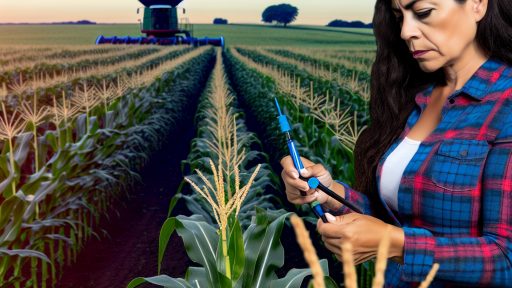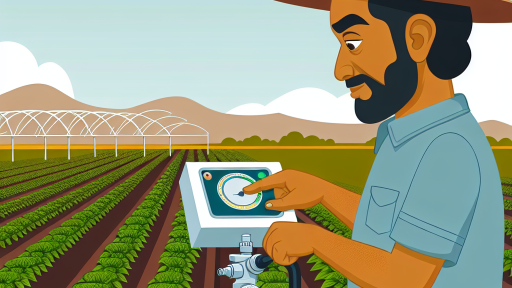Introduction to Wind Energy
Basics of Wind Energy
Wind energy harnesses the power of wind to generate electricity.
This renewable resource is abundant and sustainable.
Wind turbines convert wind kinetic energy into mechanical power.
Modern technology allows for efficient energy capture.
Importance of Wind Energy in Agriculture
Wind energy plays a crucial role in modern agriculture.
It supports reduced operating costs for farms.
Farmers can utilize wind power for irrigation systems.
They can also use it for other farming equipment.
Environmental Benefits
Wind energy is a clean source of electricity.
It helps reduce greenhouse gas emissions significantly.
Additionally, it minimizes the carbon footprint of farming operations.
Farmers contribute to environmental sustainability by using wind energy.
Enhancing Farm Productivity
Integrating wind energy into farming boosts overall productivity.
It provides a reliable energy source for irrigation and processing.
Farmers can operate equipment continuously without interruptions.
Transform Your Agribusiness
Unlock your farm's potential with expert advice tailored to your needs. Get actionable steps that drive real results.
Get StartedFurthermore, energy independence allows for greater economic stability.
Future Prospects
The future of wind energy in agriculture looks promising.
Innovations in turbine technology increase efficiency and output.
Collaboration between agricultural experts and energy companies is key.
Farmers are increasingly adopting wind energy solutions.
Current State of Wind Energy Technology
Advancements in Wind Turbine Design
Recent innovations have optimized turbine efficiency significantly.
Engineers have designed taller turbines that capture higher wind speeds.
Moreover, new blade materials enhance durability while reducing weight.
This technology allows turbines to operate under low-wind conditions.
Smart Integration with IoT
The integration of the Internet of Things (IoT) is revolutionizing wind energy.
Farmers can now monitor wind energy systems remotely using smart devices.
Real-time data helps in maximizing energy output and efficiency.
Additionally, predictive maintenance can reduce downtime substantially.
Innovative Energy Storage Solutions
Energy storage has improved, enabling better use of wind energy.
Advanced battery technologies allow excess energy to be stored efficiently.
Farmers can access stored energy during calm periods or peak demand.
These solutions enhance both energy independence and resilience.
Enhanced Site Assessment Tools
New assessment tools determine optimal turbine locations more accurately.
Remote sensing technologies provide extensive data on wind patterns.
This information aids in making informed decisions about installations.
Furthermore, simulations can predict how changes in environment affect output.
Sustainable Practices in Wind Energy
Wind energy technology supports sustainability in agriculture.
It reduces reliance on fossil fuels and lowers greenhouse gas emissions.
Additionally, using wind energy can enhance farm productivity directly.
Showcase Your Farming Business
Publish your professional farming services profile on our blog for a one-time fee of $200 and reach a dedicated audience of farmers and agribusiness owners.
Publish Your ProfileFarmers are increasingly adopting these practices for ecological benefits.
Assessing Wind Potential on Farms
Importance of Wind Assessment
Wind assessment is crucial for optimal farm productivity.
It helps farmers gauge the feasibility of wind energy applications.
By understanding wind patterns, they can make informed decisions.
Tools for Wind Potential Measurement
Farmers can utilize various tools to measure wind potential.
- Anemometers are essential for measuring wind speed.
- Wind vanes determine the wind direction accurately.
- Data loggers collect and store wind data over time.
Techniques for Wind Measurement
Several techniques exist for effectively measuring wind potential.
- Conducting a wind resource assessment provides valuable insights.
- Integrating meteorological data enhances wind analysis.
- Using remote sensing technologies offers advanced monitoring options.
Conducting a Wind Resource Assessment
Start with identifying key locations on the farm.
Next, install anemometers to gather speed and direction data.
Finally, analyze the collected data over several months.
Integrating Meteorological Data
Access historical wind speed and direction data for better insights.
This data helps to predict future wind patterns effectively.
Utilizing Remote Sensing Technologies
Remote sensing technologies allow for broad data collection.
They can offer wind profiling and facilitate accurate measurements.
Analyzing and Interpreting Data
After gathering data, analyzing it becomes necessary.
Utilize software tools to interpret the wind potential results.
Identify trends that indicate the best applications for wind energy.
Discover More: Automated Machinery Streamlining Sustainable Farming Techniques
Integrating Wind Energy Systems with Existing Farm Operations
Understanding Wind Energy Benefits
Integrating wind energy can significantly reduce energy costs for farmers.
Additionally, it provides a reliable power source for various farming operations.
This renewable energy source helps farmers transition to sustainable practices.
Assessing Wind Potential
Farmers should start by assessing their land’s wind potential accurately.
Using an anemometer, they can measure wind speed over time.
Furthermore, analyzing local wind patterns can inform the placement of turbines.
Selecting Appropriate Wind Turbines
Choosing the right turbine is crucial for optimizing farm efficiency.
Farmers must consider the turbine size, type, and capacity.
Small-scale turbines may suit individual farms, while larger models are ideal for community systems.
Incorporating Wind Energy into Daily Operations
Wind energy can power irrigation systems to improve crop yields.
It can also support heating systems in greenhouses during colder seasons.
Farmers may utilize wind energy for processing agricultural products efficiently.
Cost Considerations and Financial Incentives
Initial investment for wind energy systems can be significant.
However, various government incentives can offset these costs.
Moreover, financial benefits can arise from reduced energy bills over time.
Farmers should explore grants, loans, and tax credits available to them.
Maintenance and Longevity of Wind Systems
Regular maintenance extends the life of wind energy systems.
Farmers should inspect turbines and related equipment periodically.
Additionally, keeping up with manufacturer recommendations is essential for optimal performance.
Case Studies and Success Stories
Many farms have successfully integrated wind energy into their operations.
For example, Green Valley Farms reported a 30% reduction in energy costs.
Similarly, Windy Acres utilized wind energy to power all their irrigation needs.
These examples showcase the transformative potential of wind energy in agriculture.
Showcase Your Farming Business
Publish your professional farming services profile on our blog for a one-time fee of $200 and reach a dedicated audience of farmers and agribusiness owners.
Publish Your ProfileGain More Insights: How Biotechnology Enhances Nutritional Value Of Crops
Economic Benefits of Wind Energy for Farmers
Cost Savings
Farmers can significantly reduce their energy costs through wind energy.
Wind turbines can generate electricity, decreasing dependence on utilities.
This leads to lower monthly energy bills for farm operations.
Moreover, maintenance costs for wind energy systems are typically low.
Over time, this results in greater financial savings for farmers.
In many regions, government incentives help cover installation costs.
As a result, farmers can implement wind energy solutions more affordably.
Revenue Generation
Wind energy can also serve as a revenue source for farmers.
Farmers can sell excess electricity back to the grid.
This creates an additional income stream, enhancing farm profitability.
Cooperatives allow farmers to share resources and profits effectively.
Engaging in community wind projects can further boost revenue potential.
Participating farmers may receive lease payments for turbine placements.
See Related Content: Choosing The Right Farm Management Software For Your Farming Needs
Environmental Impact: How Wind Energy Reduces Carbon Footprint in Agriculture
Introduction to Wind Energy in Agriculture
Wind energy serves as a clean and renewable resource for farms.
It significantly reduces reliance on fossil fuels.
Moreover, farmers can harness wind power to lower operational costs.
Carbon Footprint and Sustainable Practices
Adopting wind energy directly contributes to a smaller carbon footprint.
It replaces traditional energy sources that generate greenhouse gases.
By utilizing wind power, farms can enhance sustainability effectively.
Advantages of Wind Energy on Farms
- Wind energy reduces overall energy costs.
- It provides a reliable source of power for machinery.
- Farmers can sell excess energy back to the grid.
Impact on Soil and Biodiversity
Wind energy applications also benefit soil conservation efforts.
They promote biodiversity by minimizing the use of harmful practices.
Consequently, wind farms contribute to healthier ecosystems.
Real-World Examples of Wind Energy Use in Agriculture
Green Meadows Farm has successfully integrated wind turbines.
Their energy savings have doubled over the last five years.
In addition, Sunny Fields Agricultural Cooperative has witnessed similar results.
They have significantly cut down on their carbon emissions through wind energy.
Challenges and Considerations
Despite the benefits, there are challenges in implementation.
Initial setup costs for wind turbines can be high.
Moreover, local regulations may affect deployment.
Farmers must carefully consider these factors before transitioning.
Find Out More: Climate Change Mitigation Through Agricultural Biotechnology

Case Studies: Successful Implementation of Wind Energy on Farms
Introduction to Wind Energy in Agriculture
Farmers increasingly adopt wind energy to enhance productivity.
This renewable resource offers numerous benefits, from cost savings to sustainability.
By integrating wind power, farms can improve their energy security significantly.
Case Study: Green Valley Farm
Green Valley Farm, located in Iowa, recently implemented wind turbines.
This decision resulted from rising energy costs and a desire for sustainability.
The farm installed two wind turbines, each generating 1.5 megawatts.
As a result, Green Valley reduced its energy expenses by 40%.
Showcase Your Farming Business
Publish your professional farming services profile on our blog for a one-time fee of $200 and reach a dedicated audience of farmers and agribusiness owners.
Publish Your ProfileAdditionally, the farm sells excess energy back to the grid.
Benefits Observed
- Significant reduction in operational costs.
- Increased energy independence.
- Positive environmental impact through renewable energy use.
Case Study: Maple Lane Organic Farms
Maple Lane Organic Farms in California focused on sustainability.
They adopted wind energy to complement their organic practices.
They established a small wind farm with three turbines.
These turbines provide about 60% of the farm’s energy needs.
Outcomes and Improvements
- Enhanced crop yields due to consistent energy supply.
- Lower carbon footprint, boosting the farm’s eco-friendly credentials.
- Increased farm profitability through energy savings.
Case Study: Riverbend Dairy
Riverbend Dairy in Wisconsin faced high energy consumption challenges.
To combat costs, the dairy installed a wind turbine on-site.
This turbine now generates around 50% of their electricity needs.
Consequently, the dairy reduced its annual energy costs significantly.
Advantages Gained
- Improved energy management during peak dairy operations.
- Financial savings redirected into dairy herd improvement.
- Community recognition for green efforts, enhancing local relations.
Future Prospects for Wind Energy on Farms
Looking ahead, wind energy presents growing opportunities for agriculture.
Farmers can capitalize on advancements in turbine technology.
Moreover, government incentives support renewable energy initiatives.
Partnerships with energy companies can lead to mutually beneficial projects.
The integration of wind energy will likely expand.
Future Trends in Wind Energy Applications for Agriculture
Innovative Wind Turbine Designs
Engineers are designing smaller, more efficient wind turbines for farms.
These turbines can generate energy without taking up much space.
Farmers can use this energy to power equipment and irrigation systems.
Furthermore, some applications include hybrid systems combining solar and wind energy.
Data-Driven Farming Techniques
Wind energy can power advanced sensors and drones on farms.
These technologies can monitor crop health and soil conditions in real-time.
As a result, farmers can make informed decisions about resource use.
This integration leads to increased efficiency and reduced waste.
Community-Based Wind Projects
Farmers are increasingly collaborating on community wind projects.
Such projects can lower installation costs and increase energy access.
Moreover, shared wind systems promote energy independence among rural communities.
These collaborative efforts build community resilience and sustainability.
Vertical Farming and Wind Energy Synergy
Vertical farming techniques are rising in popularity across various regions.
These farms require significant energy for lights, climate control, and irrigation.
Wind energy can provide a sustainable power source for these operations.
Consequently, this synergy helps reduce overall operating costs.
Research and Development Investments
Investors are directing funds towards wind energy innovations in agriculture.
This investment fuels the development of new technologies and systems.
Researchers are exploring potential applications for wind energy in different climates.
Ultimately, these advancements can improve agricultural productivity across regions.
Environmental Impact Reduction
Utilizing wind energy can significantly reduce a farm’s carbon footprint.
Farmers are becoming more aware of their environmental impact.
Transitioning to renewable energy sources aligns with sustainability goals.
This shift encourages better practices and enhances public perception.
Challenges and Considerations
Legal Hurdles
Legal regulations often complicate the installation of wind energy systems on farms.
Farmers must navigate local zoning laws and permits.
Showcase Your Farming Business
Publish your professional farming services profile on our blog for a one-time fee of $200 and reach a dedicated audience of farmers and agribusiness owners.
Publish Your ProfileThese regulations can vary significantly by region.
Therefore, understanding local laws is crucial before proceeding.
Farmers should also consider environmental impact assessments.
Additionally, they may need to address neighboring landowner concerns.
Financial Hurdles
Initial investment costs can deter many farmers from adopting wind energy.
Installation requires a significant financial outlay for equipment and setup.
Furthermore, farmers may need to secure financing for their projects.
Government incentives or grants may help mitigate costs.
However, accessing these funding options can be complicated and time-consuming.
Ongoing maintenance costs also factor into the project’s overall budget.
Technical Hurdles
Technical challenges play a vital role in the successful implementation of wind energy.
Farmers may struggle with selecting the right turbine for their needs.
Moreover, not every location is suitable for wind energy generation.
Wind conditions must be evaluated thoroughly to ensure feasibility.
Moreover, some farmers lack technical expertise for installation and maintenance.
Partnering with experienced professionals can alleviate these concerns.
Balancing Benefits and Challenges
Amid numerous challenges, potential benefits of wind energy remain significant.
Wind energy can provide a reliable, renewable source of power.
Additionally, it can reduce energy costs in the long run.
Farmers should weigh these benefits against the obstacles they face.
Ultimately, a well-researched approach can lead to successful implementation.
The Role of Wind Energy in Sustainable Farming Practices
Enhancing Energy Efficiency
Wind energy significantly boosts energy efficiency on farms.
It reduces reliance on fossil fuels for daily operations.
This transition lowers greenhouse gas emissions.
Moreover, farms can harness wind energy for irrigation systems.
Therefore, crops thrive with consistent water supply.
Cost Reduction
Wind energy can lead to substantial cost savings.
By generating power, farms lower their electricity bills.
This financial relief allows farmers to invest in other areas.
For instance, they may upgrade equipment or expand operations.
As a result, they enhance overall productivity and profitability.
Supporting Crop Diversity
Wind energy facilitates sustainable agricultural practices.
Farmers can diversify their crops, minimizing risks.
Using wind energy reduces the need for chemical fertilizers.
This approach promotes healthier soil and ecosystems.
Consequently, farmers cultivate a wider variety of produce.
Climate Resilience
Wind energy bolsters farms’ resilience against climate change.
Farmers can adapt practices according to shifting weather patterns.
For example, wind energy helps power smart irrigation systems.
These systems optimize water usage during droughts.
Showcase Your Farming Business
Publish your professional farming services profile on our blog for a one-time fee of $200 and reach a dedicated audience of farmers and agribusiness owners.
Publish Your ProfileTherefore, crops remain healthy and productive even in adverse conditions.
Community Development
Wind energy initiatives often involve community collaboration.
Farmers can partner with local groups to develop wind farms.
These collaborations create jobs and promote local economies.
Additionally, surplus energy can be sold back to the grid.
This revenue stream supports both the farm and the community.
Additional Resources
Renewable energy as an alternative source for energy management …




